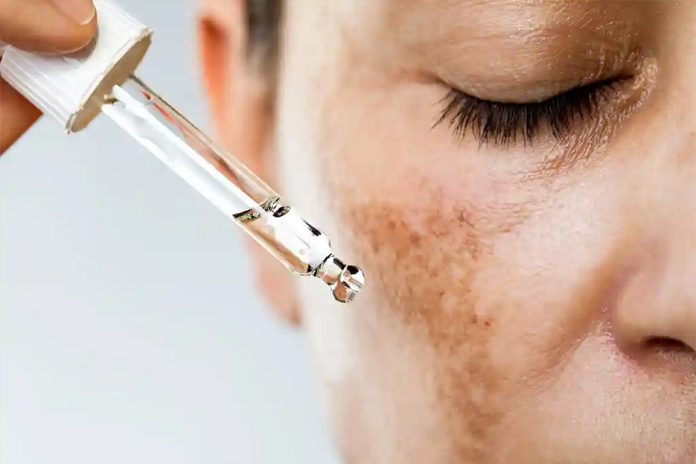Have you ever gotten rid of a pesky acne pimple but found yourself with a constant reminder in the form of a stubborn dark mark? Or have you recovered from a blistering burn courtesy of your curling iron or oven, only to be left with a lingering brown patch that never seems to fade? Perhaps you’ve been wondering about those feathery brown patches on your cheeks that get worse during the summer.
If any of those scenarios sound familiar, then you, like me, have been personally victimized by hyperpigmentation.
What Is Hyperpigmentation?
Hyperpigmentation refers to excess pigment within the skin, causing certain areas to appear darker due to an increase in melanin production. Melanin is responsible for our unique eye, skin, and hair color. Quick skin biology lesson: Skin color is determined by the activity of melanocytes, which are specialized cells responsible for producing pigment within melanosomes. Those with dark skin tones have larger melanosomes, which contain more melanin pigment relative to people with lighter skin. Melanin serves important functions in our bodies, such as absorbing harmful UV rays and protecting our cells from sun damage.
Although we recognize melanin’s critical role, we certainly don’t appreciate it too much and irregularly dispersed melanin deposition in our skin – also known as hyperpigmentation. Unfortunately, this is a very common skin concern that can have a huge psychological impact and negatively affect your quality of life.
What Are Common Causes of Hyperpigmentation?
There are many complex disorders of hyperpigmentation, but for now, let’s focus on the most common ones:
Post-inflammatory hyperpigmentation
Post-inflammatory hyperpigmentation (PIH) is most often seen in darkly pigmented skin. Not only is it more common in darker skin, but it tends to be more severe and last longer.
PIH develops after inflammation or injury to the skin. Examples include acne, bug bites, cuts and scrapes, and chronic skin conditions such as psoriasis and eczema. PIH is exacerbated by ongoing inflammation, so the number one rule in treating PIH is to treat the underlying problem.
Melasma
Another common cause of hyperpigmentation is melasma, a chronic, relapsing condition mainly driven by two things: sun exposure and hormones. It is most common in adult females and causes tan patches to appear in sun-exposed areas of the face (cheeks, temples, upper lip, forehead).
It is associated with states of elevated estrogen – most commonly in women on birth control pills and women who are pregnant. For this reason, it is nicknamed the “mask of pregnancy.”
Photoaging (sun spots)
Photoaging refers to skin findings that occur due to cumulative exposure to sunlight – namely wrinkles, sun spots, and loss of skin elasticity. Sun spots, or solar lentigines, go by a variety of names: liver spots, age spots, and senile lentigos. (Probably my least favorite of the nicknames!) They are most commonly in people with chronically sun-damaged skin. These round, oval, or irregularly shaped flat spots can be tan, light brown, or dark brown and are found on sun-exposed body parts.
How Is Hyperpigmentation Treated?
There are two common principles when it comes to treating most forms of hyperpigmentation: sun protection and patience. While PIH generally resolves over time, fading dark marks from the various causes can take weeks, months, or even years.
PIH, melasma, photoaging, and most other causes of hyperpigmentation are all exacerbated by ultraviolet (UV) exposure. If you are bothered by dark spots and are investing your time and money into fancy creams, lasers, and chemical peels, please don’t skip the sunscreen. A broad-spectrum (UVA and UVB) sunscreen with a minimum SPF of 30 should be worn when spending time outdoors; with prolonged exposure, don’t forget to reapply every 2 hours.
Aside from sun protection, there are a variety of therapies available to help speed up the resolution of hyperpigmentation. A combination approach employing both topicals and procedures might be the most effective.
Topicals used to treat hyperpigmentation include:
- Hydroquinone
- Retinoids
- Azelaic acid
- Cysteamine
- Tranexamic acid
- Vitamin C
- Niacinamide
- Kojic acid
- Alpha/beta hydroxy acids (glycolic acid, lactic acid, mandelic acid, salicylic acid)
Procedures used to treat hyperpigmentation include:
- Chemical peels
- Intense pulsed light (IPL)
- Microneedling
- Laser
- Dermabrasion
It is important to note that treatment – especially when it comes to devices – is not
one-size-fits-all and may vary by the specific underlying cause. Additionally, though many topicals are easily found on the shelves of your local store or online, some require a prescription. You may need to talk to an expert to determine which devices are safe for your skin type and whether you would benefit from prescription-strength management of your condition.









